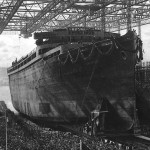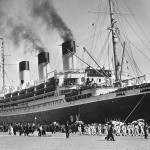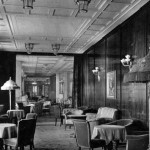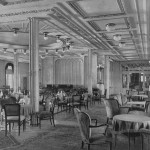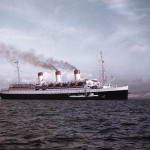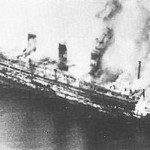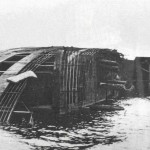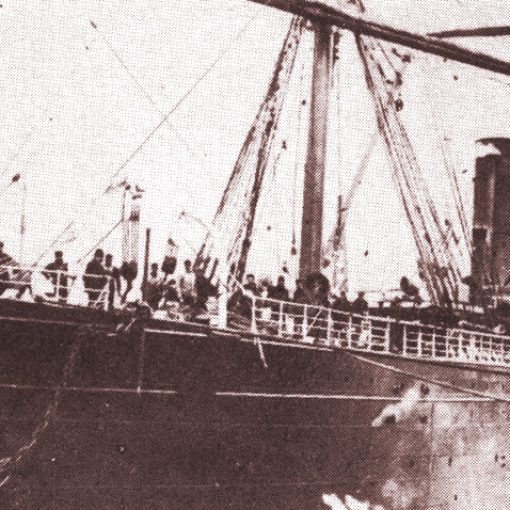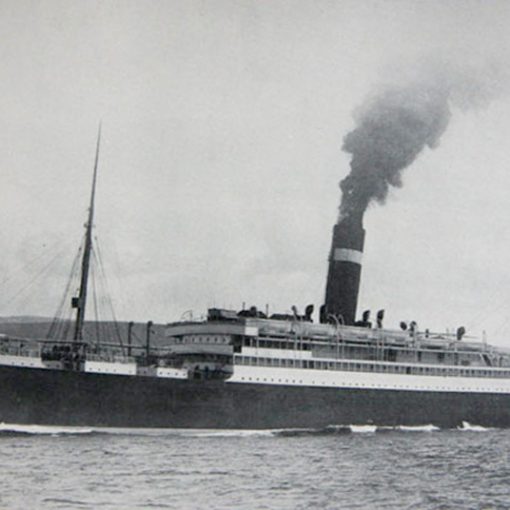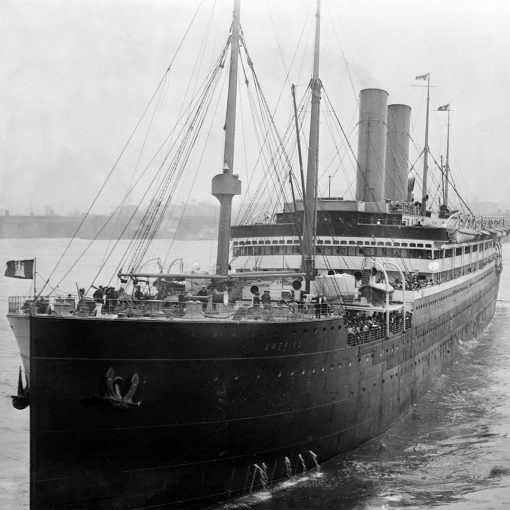1927 – 1945
By the mid-1920s, there were three major shipping companies in Germany. Besides the Hamburg-Amerika Line and the Norddeutscher Lloyd, who both operated on the North Atlantic, there was also the Hamburg-South America Line, in Germany popularly known as Hamburg-Süd. The company had been founded on November 4th 1871, as a result of the growing emigration from Germany to South America. The company soon established itself as one of the best on the South American trade, and grew larger and larger into the first decade of the 20th century.
However, in 1914, the First World War broke out. After four years of bloody battles, the German Empire was defeated in 1918. When the victorious allied gathered at Versailles in 1919 to dictate the peace terms, they were ruthless. The allied forces had lost many ships during the conflict, and therefore German ships were taken as compensation. As a German shipping company, the Hamburg-Süd could not escape this verdict. The grand Hamburg-Süd fleet was stripped bare, with all ships taken as war reparations.
The following year, in 1920, the Hamburg-Süd directors set out on the mission of rebuilding the company’s fleet. But due to the harsh times of war, funds were low and the task would not be an easy one. The first vessels that were commissioned were three small sailing schooners. In addition, other vessels were chartered from several companies to fill the huge gaps. Hamburg-Süd quickly rose towards new heights, and by the end of 1920 the company put their first post-war passenger steamer into service – the 5,745-ton Argentina, capable of making 10 knots.
Seven years later, Hamburg-Süd had recuperated and risen above its pre-war heights. It was now decided to commission a new flagship for their fleet, a ship that would be the grandest and most luxurious on the South American run. The new vessel was ordered from the prominent shipbuilders of Blohm & Voss in Hamburg.
On May 14th 1927, the new ship was launched and christened the Cap Arcona. Five months later, on October 29th, she had been fitted out and would soon be ready to set out on her first voyage across the Atlantic. Not only was she the largest ship on the South American trade, but her service speed of 20 knots would also make her the fastest. Hamburg-Süd had great expectations in their new ship, and soon she would be put to the test. On November 19th 1927, the Cap Arcona left Hamburg on her premiere voyage. Her destination was La Plata. The new ship soon proved her worth, and everything about her was completely satisfactory. Hamburg-Süd was once again one of the world’s foremost shipping lines.
The German emigration to South America continued, and by 1929 the passenger shipping with South America reached its zenith with a total 57,859 passengers. The following ten years meant continued success for the Hamburg-Süd, and in 1939 they operated 52 ships of a total tonnage of 385,000 grt. But 1939 was to become the year when a second global conflict broke out. On the morning of September 1st, Adolf Hitler’s German forces marched into Poland and immediately made enemies of Great Britain and her allies.
In 1940, the Cap Arcona was taken over by the German Kriegsmarine for use as a naval accommodation ship in the German controlled Baltic port of Gotenhafen (now Gdynia). Here she would provide housing for Kriegsmarine sailors. Although a considerably large vessel, the Cap Arcona was never to be put to use as a troop transport. She remained anchored in Gotenhafen for the following five years, seeing no action whatsoever.
Yet in the middle of this dull and monotonous task, the Cap Arcona went through a brief career as an actress. While the battles raged across the globe, Hitler’s propaganda minister Goebbels decided to make a powerful movie to show how good the German people was and also how corrupted and evil its enemies were. The subject for the film was Titanic, and the idea for the film was easy: All of the ship’s crew, British of course, were corrupted and ill-minded. The only righteous person in the movie was a fictitious German officer on board.
Herbert Selpin was chosen as the film’s director, in spite the fact that he was not very Nazi-friendly. Yet he had a remarkable talent of filming maritime subjects, and was therefore chosen for the job. During the filming on board the Cap Arcona, Selpin encountered trouble. The German naval officers kept flirting with women extras, and made the shooting very difficult. At one point, Selpin lost his temper and made a number of harsh comments about the German navy. Goebbels found out about this, and it was not long before Selpin was arrested. According to Gestapo, he later ‘committed suicide’ in his cell. Werner Klingler was chosen to finish the film, and eventually it was ready for a test screening. However, Goebbels found that the movie would be very bad propaganda. The panic scenes were very realistic, and could be compared to the situations that occurred during Allied bombing raids. Goebbels was furious and banned the film. It wasn’t until 1955 that it first could be shown in West Germany.
By the end of 1944, the tables had turned on Germany. Although Hitler’s ‘Blitzkrieg’-tactics had been very successful during the first years of the conflict, the German forces were now on the retreat from both the eastern and western fronts of the Reich. Seeing that the war was lost, Germany was on the run. The Kriegsmarine increasingly turned its attention to the massive sea rescue operation taking place in the Baltic Sea. Between late 1944 and May of 1945, over 2,000,000 refugees were transported to the west from the wake of the advancing Soviet Armies. In all, 25,000 were lost during the entire operation, making it not only the largest sea rescue and transport operation in history, but also one of the most safe as well. As the sea rescue operation in the Baltic became increasingly more frantic, every available German ship was put into use in making the run to the eastern ports to take out refugees, sick, wounded, and fleeing soldiers.
In 1945, in the closing months of World War II, the Cap Arcona was used to rescue 26,000 refugees in three separate runs between the besieged eastern ports and the west. After her third and final run, exhausted and worn-out from lack of maintenance and constant use, the Cap Arcona was released from service by the German Naval High Command. She was no longer a ship of the German Kriegsmarine and was ordered to Neustadt Bay near Kiel where she was to be paid off. However, when the Cap Arcona reached the Neustadt Bay she was given new orders. She was to be transformed into a floating prison to transport inmates from the Neuengamme Concentration Camp near Hamburg. Between April 26th and 28th 1945, more than 5,000 prisoners were taken on board the former luxury liner. She was then supposed to leave the area, but due to lack of fuel she could not travel anywhere.
Tragedy struck a few days later, on May 3rd 1945. British Typhoon-class bombers made a raid over the area and spotted the Cap Arcona in the waters outside the city of Neustadt. Not knowing her cargo of concentration camp prisoners, the pilots could not resist the perfect target sitting dead in the water. The bombs were soon falling on the Cap Arcona, turning the one-time luxury liner into a floating hell. Smoke filled the passageways and the ship quickly took on a dangerous list. Many of the ship’s occupants somehow made it out on the top decks, but this did by no means guarantee safety. The bombs kept coming, and it would be impossible to survive for long in the cold waters surrounding the vessel.
When the bombs finally stopped, only a few of the prisoners had managed to escape. The Cap Arcona was lying on her side in the Neustadt Bay, she had taken with her some 5,000 people, perhaps more. Ironically, the following day British troops marched into Neustadt. They would have been able to rescue all the prisoners from the Cap Arcona.
The wreckage of the Cap Arcona remained at the spot until the end of the war, when she was finally broken up.
Specifications
- 676 feet (206.5 m) long
- 84 feet (25.7 m) wide
- 27,560 gross tons
- Steam turbines turning two propellers
- 20 knot service speed
- Passenger capacity of 1,315 people

